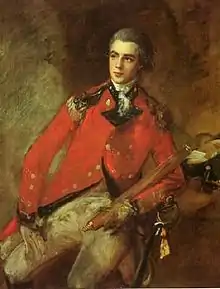William Cathcart, 1st Earl Cathcart
General William Schaw Cathcart, 1st Earl Cathcart KT, PC, PC (Ire) (17 September 1755 – 16 June 1843) was a Scottish soldier and diplomatist.
The Earl Cathcart | |
|---|---|
 The 1st Earl Cathcart | |
| Nickname(s) | Cath |
| Born | 17 September 1755 Petersham, England |
| Died | 16 June 1843 (aged 87) Glasgow, Scotland |
| Allegiance | |
| Service/ | |
| Rank | General |
| Commands held | Commander-in-Chief, Scotland Commander-in-Chief, Ireland |
| Battles/wars | American Revolutionary War |
| Awards | Knight of the Order of the Thistle Order of St. Andrew (Russia) Order of St. George of the Fourth Degree (Russia) |
Early life
Cathcart born at Petersham, London, on 17 September 1755, and educated at Eton College.
Military career
In 1771 he went to St. Petersburg, where his father, Charles Cathcart, 9th Lord Cathcart, a general in the army, was ambassador. He became an excellent horseman in Russia then from 1773 to 1777 he studied law at the University of Glasgow and was afterwards called to the Scottish Bar.[1] He succeeded to the lordship upon his father's death in 1776, and in 1777 he obtained a commission in the 7th Dragoons.[2]
Proceeding to America in 1777, he had before the close of his first campaign twice won promotion on the field of battle. He transferred to the 17th Light Dragoons. In 1778 he further distinguished himself in outpost work, and at the Battle of Monmouth he commanded an irregular corps, the British Legion, with conspicuous success; for a time also he acted as quartermaster-general to the forces in America. He returned home in 1780, and in February 1781 was made captain and lieutenant colonel in the Coldstream Guards.[2]
He was elected a representative peer for Scotland in 1788, and in 1792 he became colonel of the 29th Foot. He served with distinction in the campaigns in the Low Countries, 1793–1795, in the course of which he was promoted major general; and in 1801 he was made a lieutenant general, having in the meanwhile received the appointments of Vice Admiral of Scotland (1795), privy councillor (1798), and colonel of the 2nd Life Guards (1797).[2]
From 1803 to 1805 Lord Cathcart was Commander-in-Chief in Ireland, and in the latter year he was sent by Pitt to supersede Sir George Don in command of the 14,000 strong British expedition to Hanover.[2] He occupied Hanover on 14 December and joined with Werdereffsky's Russian column of Tolstoi's corps. After skirmishes with the French forces of Gabriel Barbou des Courières at Springe, Cathcart was forced to withdraw after the Franco-Prussian agreement of 27 January 1806 handing over Hanover to Prussia, and re-embarked for the United Kingdom on 7 February 1806.
After the recall of this expedition Cathcart commanded the forces in Scotland until 1807, when he was placed in charge of the expedition to Copenhagen, which surrendered to him on 6 September. Four weeks later he was created Viscount Cathcart of Cathcart and Baron Greenock of Greenock in the peerage of the United Kingdom, resuming the Scottish command on his return from the front.[2]
On 1 January 1812 he was promoted to the full rank of general, and a few months later he proceeded to Russia as ambassador and military commissioner. In the latter capacity he served with the headquarters of the allies throughout the War of Liberation (1812–1814); his success in the delicate and difficult task of maintaining harmony and devotion to the common cause amongst the generals of many nationalities was recognized after the war by his elevation to the earldom (July 1814). He then went to St. Petersburg, and continued to hold the post of ambassador until 1820, when he returned to the United Kingdom.
He died at his estate near Glasgow on 16 June 1843.[2] He is buried in Paisley Abbey with a monument by William Mossman erected in 1848.[3]
Family
Cathcart married Elizabeth Elliot, the daughter of the lieutenant-governor of New York Andrew Elliot, on 10 April 1779. The couple had ten children, the first five being born in the 1780s. Their first child, Louisa, was born in New York on 25 January 1780, but died soon after her birth. Other children included the army officers Sir George Cathcart and Sir Charles Cathcart, both of whom became generals, the latter inheriting the peerage on his father's death.[2] William's first-born son, William Cathcart, entered the Royal Navy but died of yellow fever in 1804 while in command of his ship HMS Clorinde.[4] Cathcart took two of his sons with him during his appointment as ambassador to Russia, Captain Frederick Macadam Cathcart served as his private secretary and Lieutenant George Cathcart functioned as his aide-de-camp. Cathcart's last son, Adolphus Frederick Cathcart, was born on 28 June 1803.
Citations and references
Citations
- C. J. Barrington (pub) 1814, p. 3.
-
 One or more of the preceding sentences incorporates text from a publication now in the public domain: Chisholm, Hugh, ed. (1911). "Cathcart, William Schaw Cathcart, 1st Earl". Encyclopædia Britannica. 5 (11th ed.). Cambridge University Press. p. 518.
One or more of the preceding sentences incorporates text from a publication now in the public domain: Chisholm, Hugh, ed. (1911). "Cathcart, William Schaw Cathcart, 1st Earl". Encyclopædia Britannica. 5 (11th ed.). Cambridge University Press. p. 518. - Dictionary of British Sculptors: 1660–1851, Rupert Gunnis
- John Knox Laughton, ed. (1902). Naval Miscellany Volume 1. 20. Naval Record Society.
References
- C. J. Barrington (pub) (1814). The Military Panorama, Or, Officer's Companion.CS1 maint: ref=harv (link)
See also
External links
| Wikisource has the text of the 1885–1900 Dictionary of National Biography's article about Cathcart, William Schaw. |
- Hansard 1803–2005: contributions in Parliament by the Earl Cathcart